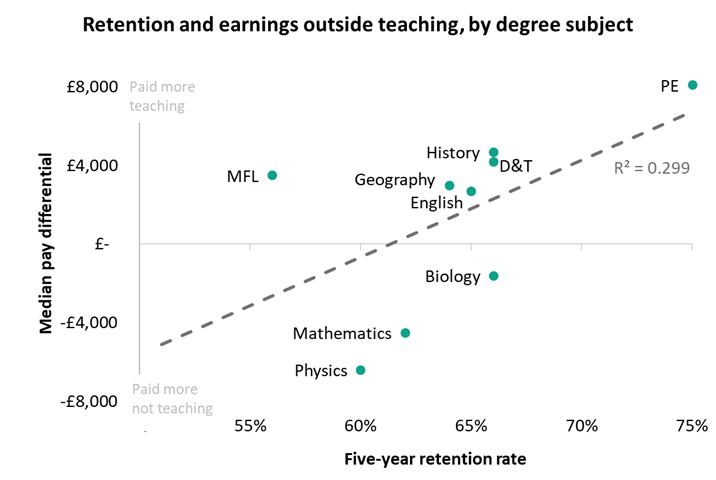A recent EPI report on the state of the teacher labour market showed that there was strong evidence for providing salary supplements to teachers to alleviate shortages in subjects such as maths and science.
Sam Sims, researcher at UCL Institute of Education Centre for Education Improvement Science and author of previous work on teacher supply, builds on this research by examining the latest evidence on the drivers behind poor teacher retention rates.
A prevailing view is that workload is mostly to blame for poor teacher retention rates in England. Education Secretary, Damian Hinds, has stated that tackling workload is his primary strategy for reducing teacher shortages. It’s easy to see why: international evidence shows that English teachers’ workload is high compared to other countries and professions, and has increased in recent years. Teachers themselves often cite excess workload as their main problem in surveys.
There are two problems with this theory: first, working hours are higher, and have risen faster, for classroom teachers in primary schools. Yet retention in primary (78% teachers remain after three years) is far better than in secondary (69%). Indeed, interestingly, in stark contrast with secondary, there is no clear national shortage of primary teachers. Secondly, the only published study which looks at the relationship between workload and whether teachers actually leave their jobs finds no association between the two.
Of course, none of this is to say that we shouldn’t be tackling workload. Teachers deserve to return home from work feeling fulfilled, not exhausted. But it does raise very serious questions about whether workload is the most important reason for shortages.
What else might explain declining retention rates? A prime candidate is teachers’ pay. This has fallen further behind private sector pay in every year for the last decade (except 2009). Moreover, three studies from the US show that increasing pay for teachers in shortage subjects (who have higher earnings potential outside teaching) significantly increases retention.
Unlike workload, pay also fits with the primary/secondary retention data. Graduates with STEM degrees earn more outside teaching, on average, but teachers with non-STEM degrees tend to earn more as teachers. Almost one in three (28%) secondary classroom teachers have a STEM degree but, in primary schools, it is only one in twenty (6%). The declining competitiveness of teachers’ salaries is therefore much more likely to affect secondary teachers.
The Department for Education recently published five-year retention rates by degree-subject. Combining this with the Migration Advisory Committee’s estimates of the teaching/non-teaching earnings gaps gives the relationship shown in the chart below. Each dot on the graph is a group of teachers that share a degree subject. The vertical axis shows the gap between median pay inside and outside of teaching: the outside pay gap. Degree subjects above the horizontal line tend to earn more in teaching than outside and subjects below the line tend to earn more outside teaching.

The chart tells a clear story: the worse the outside pay gap, the worse the retention rate. Indeed, the outside pay gap explains (in a statistical sense) almost a third (30 per cent) of the differences in retention by degree subject. The three US studies mentioned earlier (summarised here) strongly suggest that the underlying relationship is causal.
Again, none of this indicates that workload is unimportant. It probably does contribute to teachers leaving the profession, but the evidence is far weaker than for pay. Indeed, the government’s main evidence-base for the importance of workload is a consultation, which collected responses from a self-selecting sample. Workload is very unlikely to be the most important thing.
The good news is that inadequate pay is much simpler to rectify than workload. A recent report by EPI’s Luke Sibieta called for early-career salary bonuses for teachers in shortage subjects. The government has already trialled such a policy for maths teachers. They should now do the same for scientists. Previous research has shown that this retention policy would be better value for money than the current approach of trying to incentivise recruitment – which is akin to topping up a leaky bucket.
The importance of pay for improving retention may not be something that Damian Hinds is keen to admit. But if the Secretary of State is committed to making progress on reducing this problem in the current parliament, the evidence suggests that he should prioritise it.

